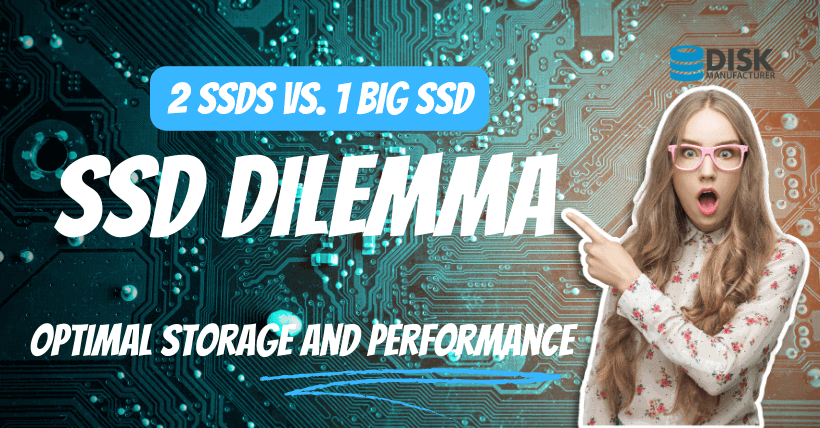Introduction
In today’s technology-driven world, solid-state drives (SSDs) have gained immense popularity due to their faster performance and improved reliability compared to traditional hard disk drives (HDDs). When it comes to upgrading or building a new computer system, one common question that arises is whether to use two smaller SSDs or a single larger SSD. In this article, we will explore the advantages and considerations of both options to help you make an informed decision.
Advantages of Using 2 SSDs
Using two smaller SSDs in a computer system offers several advantages:
1. Enhanced Performance
By employing two SSDs in a RAID (Redundant Array of Independent Disks) configuration, you can significantly boost the performance of your storage system. RAID setups, such as RAID 0, allow data to be distributed across multiple drives, enabling parallel data access and faster read/write speeds.
2. Increased Reliability
When using two SSDs in a RAID configuration, you can benefit from increased data redundancy. RAID setups like RAID 1 mirror the data between the drives, ensuring that if one drive fails, the data remains accessible on the other drive. This redundancy provides an added layer of protection against data loss.
3. Flexibility in Storage Configuration
Having two separate SSDs gives you the flexibility to allocate specific drives for different purposes. You can use one SSD for the operating system and frequently accessed programs, while dedicating the other SSD for storing large files, such as multimedia content or games. This separation allows for efficient organization and optimized storage utilization.
Advantages of Using 1 Big SSD
Using a single larger SSD also offers several advantages:
1. Simplicity and Cost-effectiveness
Opting for a single big SSD simplifies the installation process and reduces the number of components in your system. With fewer drives to manage, you can enjoy a cleaner and less cluttered setup. Additionally, purchasing a single larger SSD can often be more cost-effective compared to buying two smaller SSDs with the same combined storage capacity.
2. Seamless Storage Experience
Using a single SSD eliminates the need for configuring and managing RAID setups, which can be complex for less experienced users. With a single SSD, you can enjoy a seamless storage experience, as there is no need to worry about data distribution or redundancy configurations. This simplicity can be particularly beneficial for individuals who prioritize ease of use.
Considerations for Choosing Between 2 SSDs and 1 Big SSD
When deciding whether to use two SSDs or a single larger SSD, it’s important to consider the following factors:
1. Storage Needs and Budget
Evaluate your storage requirements and budgetary constraints. If you require a substantial amount of storage capacity and have a flexible budget, using two SSDs might be a viable option. However, if your storage needs are moderate and you prefer a cost-effective solution, a single big SSD would suffice.
2. Performance vs. Simplicity
Consider whether you prioritize enhanced performance and data redundancy or simplicity and ease of use. If you rely on faster data access and are willing to invest time in configuring RAID setups, using two SSDs can deliver superior performance. On the other hand, if you prefer a straightforward and hassle-free storage solution, a single big SSD provides a seamless experience without the need for RAID configurations.
3. Future Expansion
Think about your future needs for storage expansion. If you anticipate requiring additional storage capacity down the line, using two smaller SSDs allows for easier scalability. You can simply add another SSD to the system without replacing the existing drives. Conversely, if you believe your storage needs will remain relatively stable, a single larger SSD provides sufficient space for your current and future requirements.
4. Reliability and Data Backup
Consider your priorities regarding data redundancy and backup. If data security and reliability are paramount, using two SSDs in a RAID configuration offers added protection against drive failure. However, if you have other backup measures in place, such as regular data backups to external devices or cloud storage, a single SSD may be sufficient for your needs.
Conclusion
In conclusion, the choice between using two smaller SSDs or a single larger SSD depends on your specific requirements and preferences. Two SSDs in a RAID configuration offer enhanced performance, increased reliability, and flexibility in storage allocation. On the other hand, a single big SSD provides simplicity, cost-effectiveness, and a seamless storage experience.
Ultimately, assess your storage needs, budget, performance expectations, and future expansion plans to make an informed decision. Both options have their merits, so choose the one that aligns best with your individual circumstances.
FAQs
Q1: Can I mix different SSD models and capacities in a RAID setup?
A1: It is generally recommended to use SSDs with similar models and capacities for optimal performance and compatibility in RAID configurations.
Q2: What happens if one drive fails in a RAID setup with two SSDs?
A2: In a RAID 1 configuration, if one drive fails, the other drive will continue to function, and your data remains accessible. However, it is crucial to replace the failed drive as soon as possible to restore data redundancy.
Q3: Do RAID configurations impact the lifespan of SSDs?
A3: RAID configurations themselves do not significantly impact the lifespan of SSDs. However, it is important to note that the lifespan of individual SSDs may vary, and regular backups are always recommended.
Q4: Are there any drawbacks to using two smaller SSDs?
A4: One potential drawback is the increased complexity of managing RAID configurations. Additionally, the cost of two smaller SSDs may be higher compared to a single larger SSD with the same combined storage capacity.
Q5: Can I upgrade from using two SSDs to a single bigger SSD in the future?
A5: Yes, it is possible to upgrade your storage setup from using two SSDs to a single larger SSD. However, it may require data migration and reinstallation of the operating system and applications.









